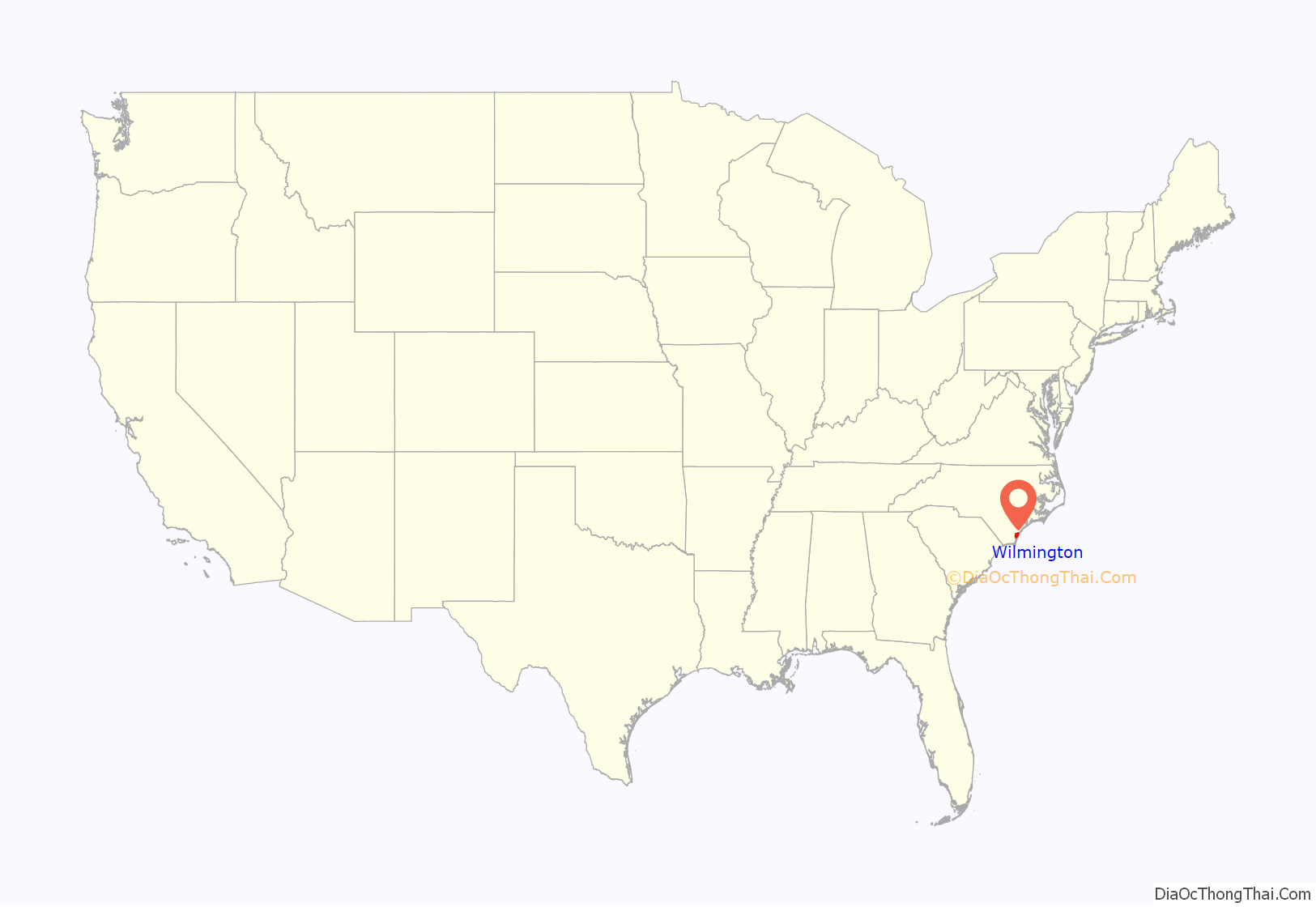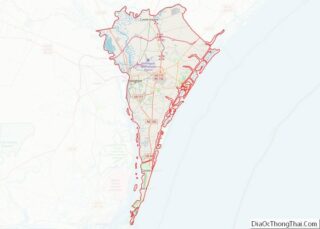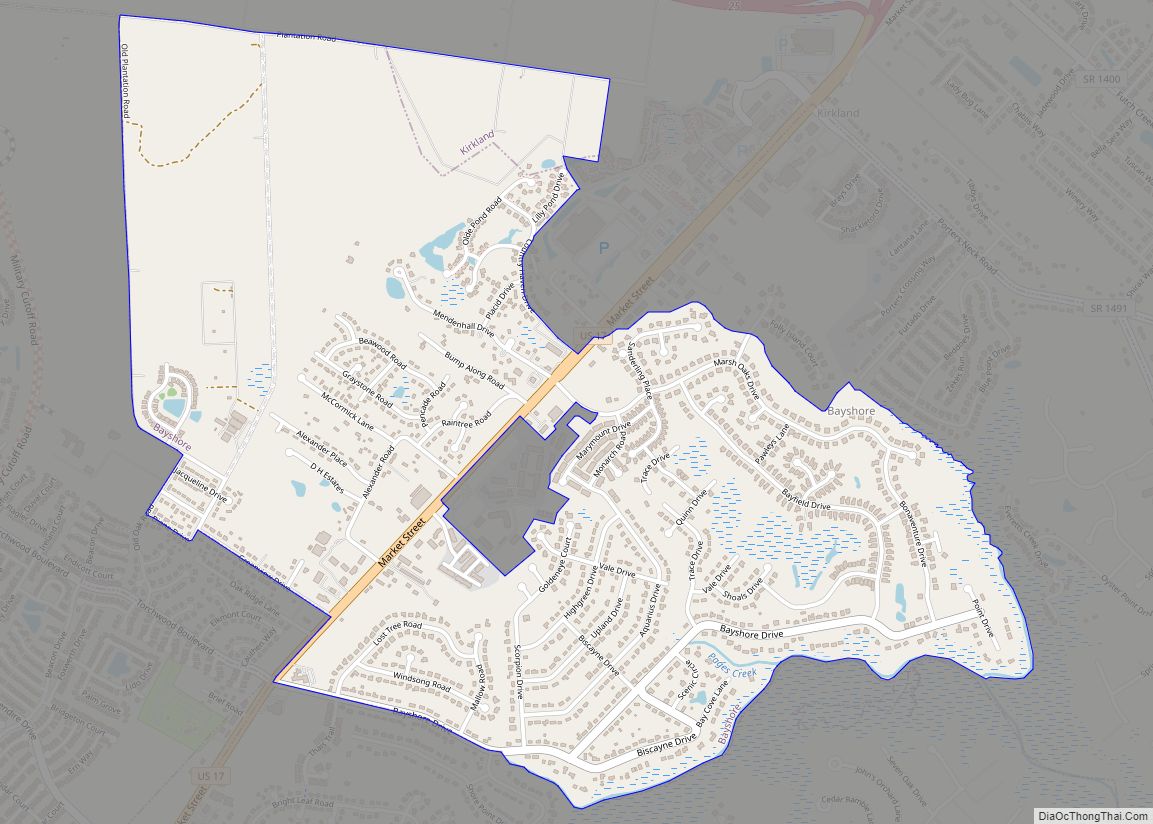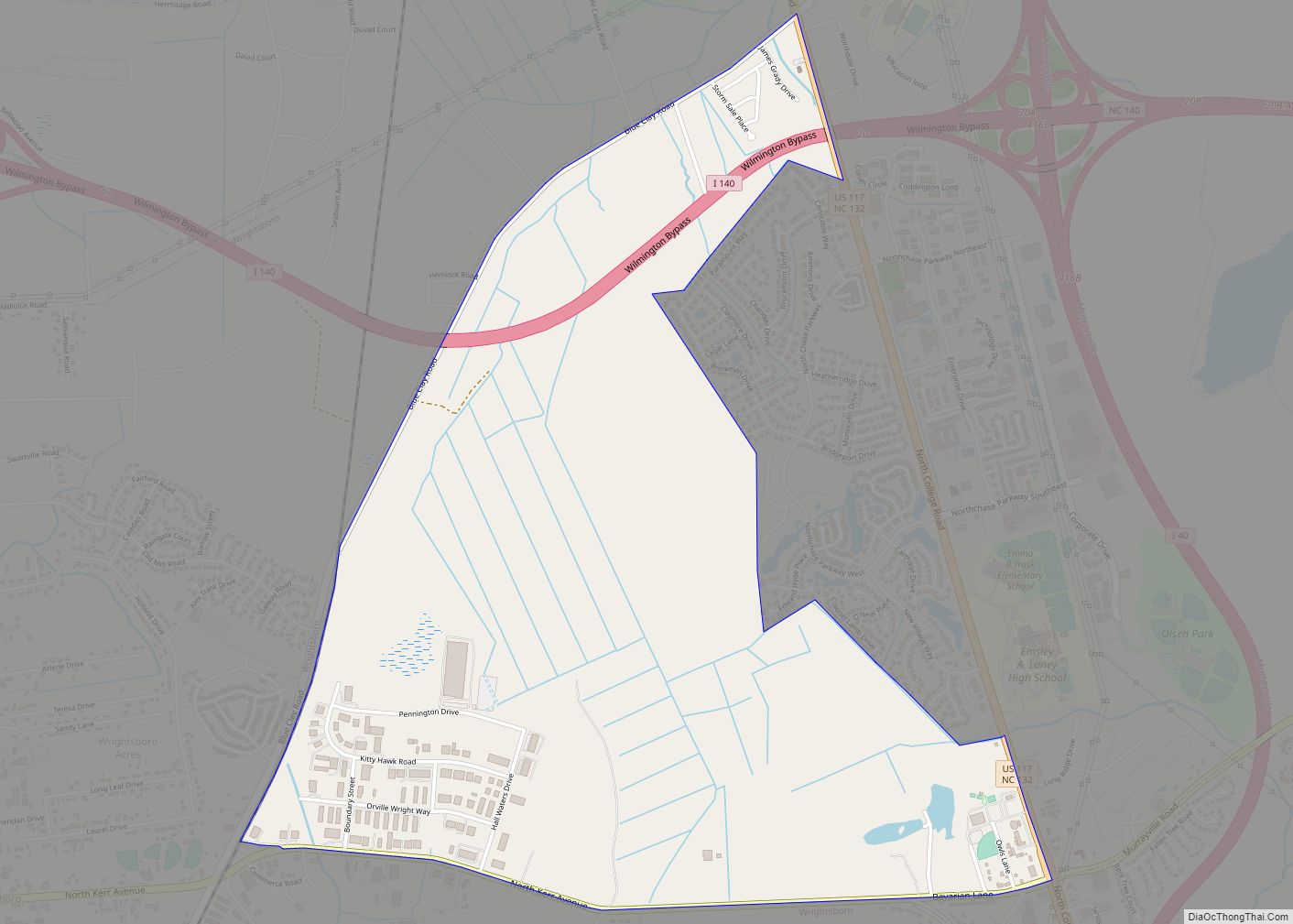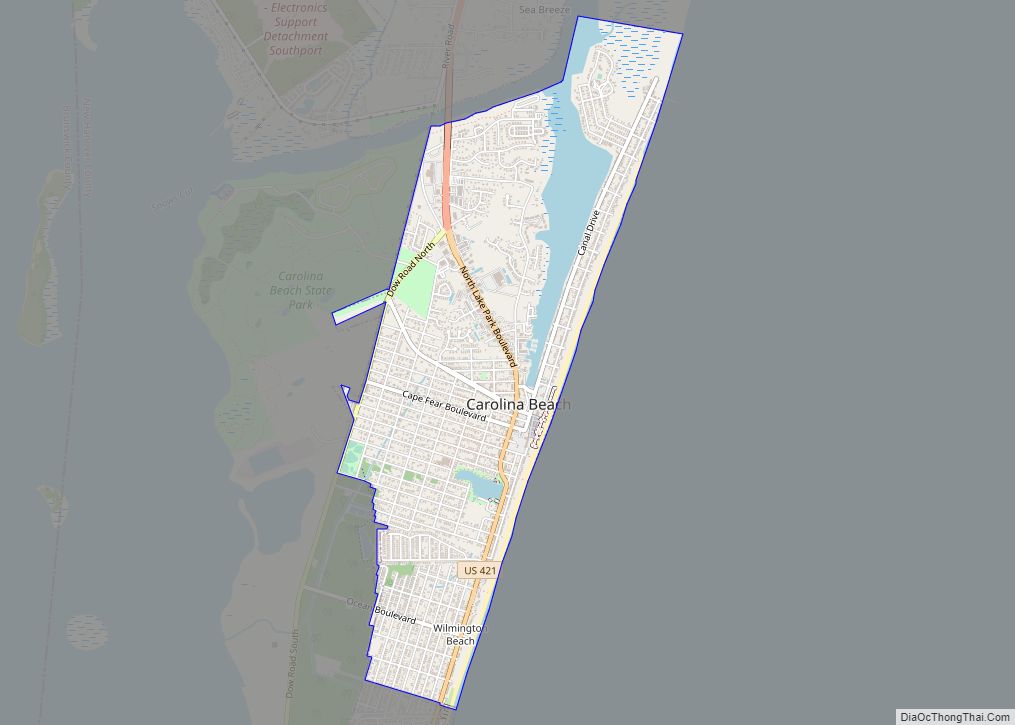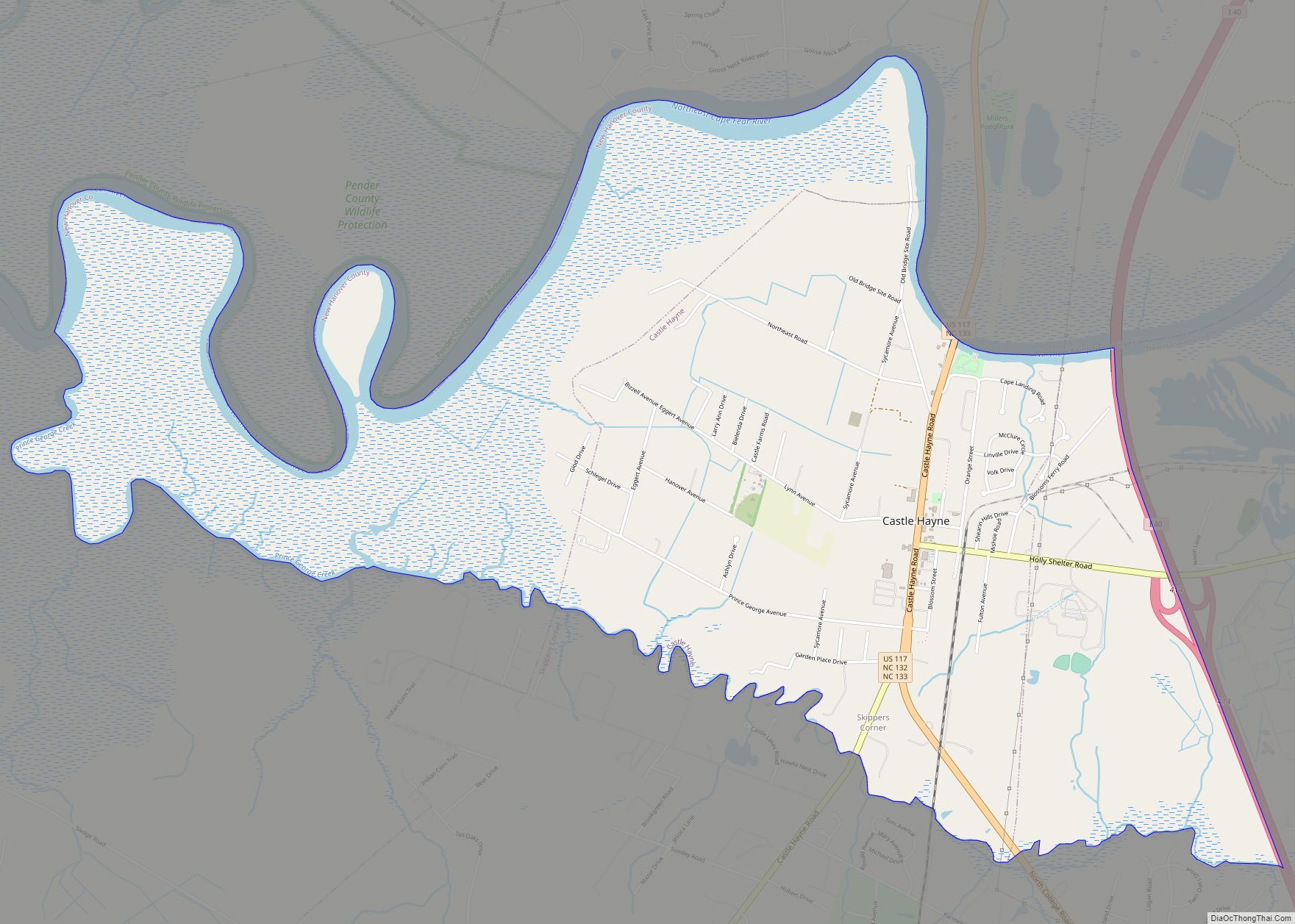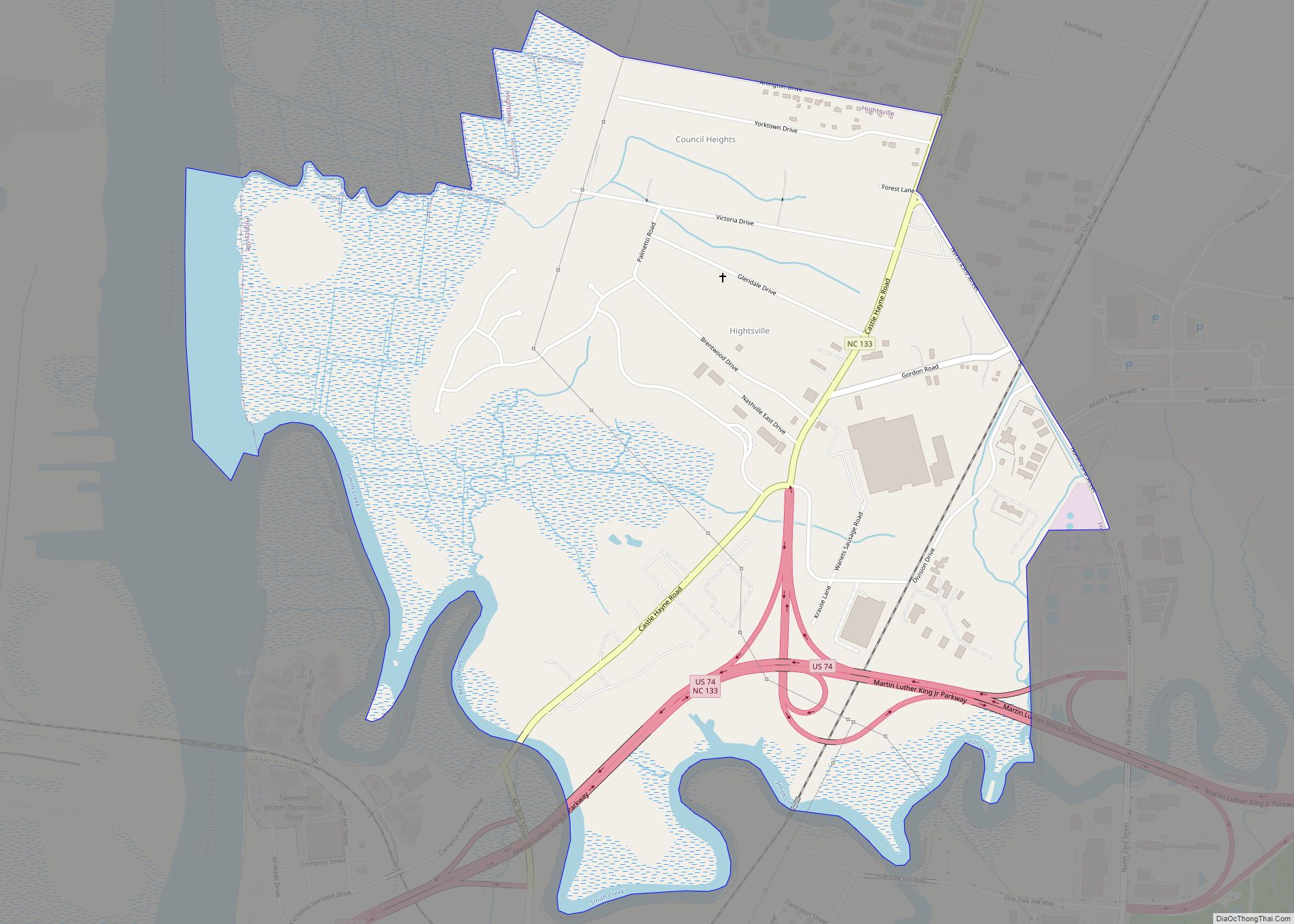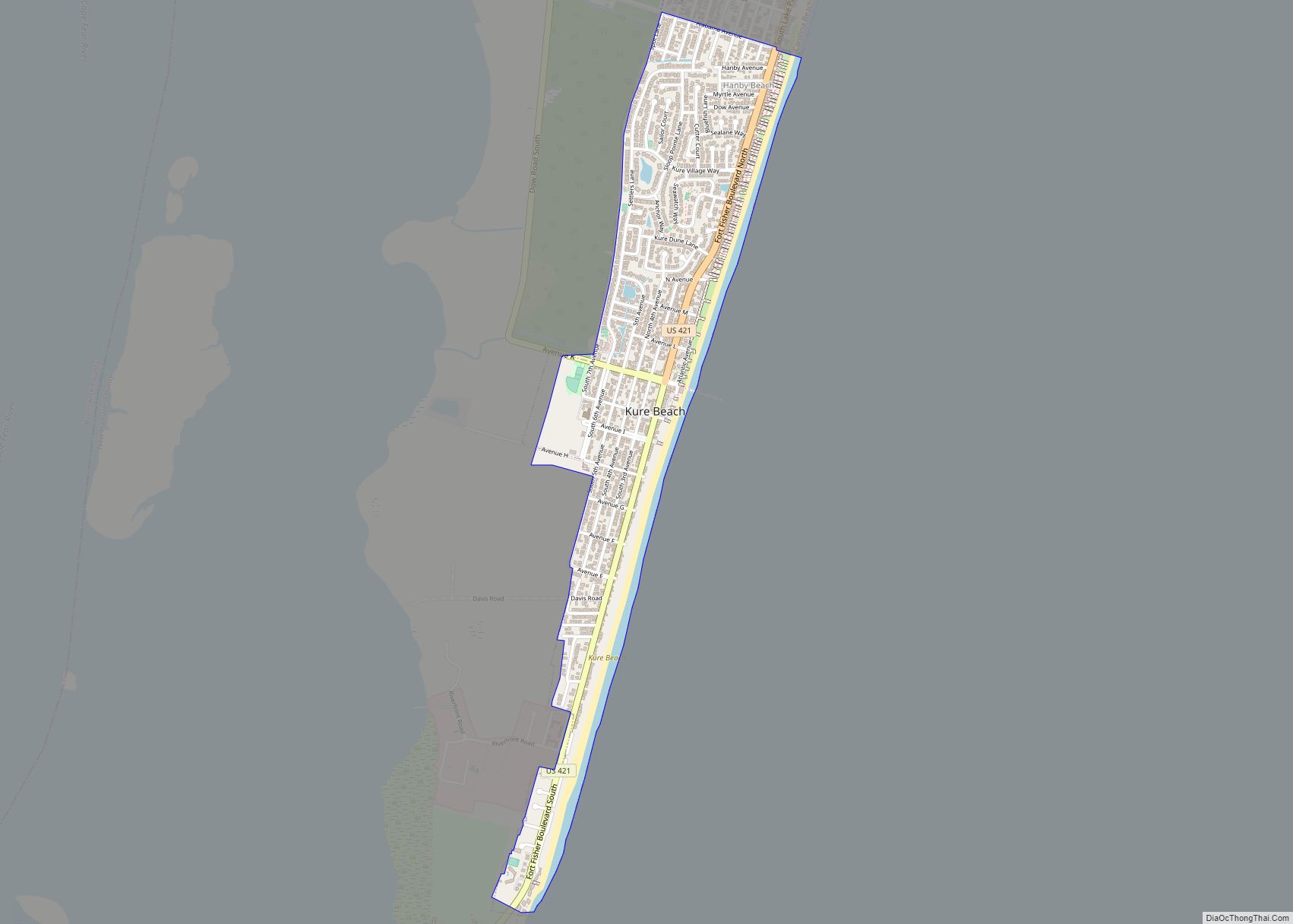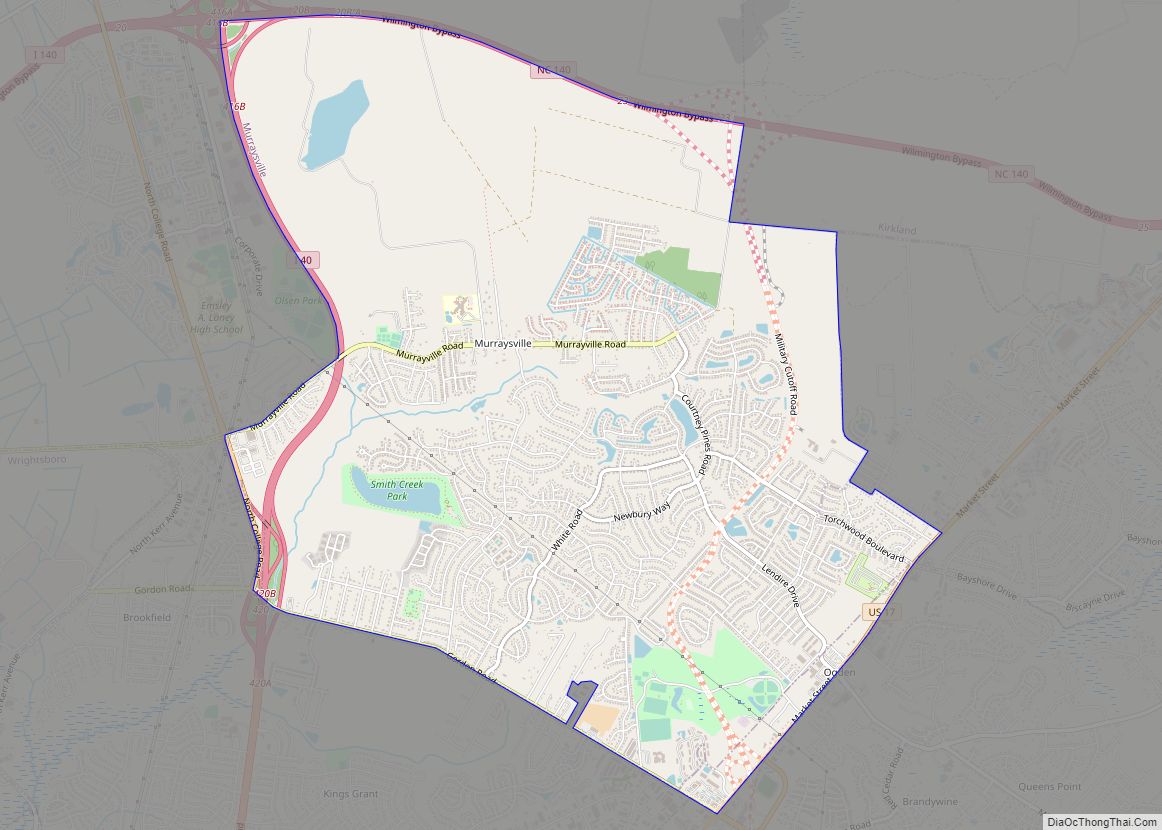Wilmington is a port city in and the county seat of New Hanover County in coastal southeastern North Carolina. With a population of 115,451 at the 2020 census, it is the eighth-most populous city in the state. Wilmington is the principal city of the Wilmington Metropolitan Statistical Area, which includes New Hanover and Pender counties in southeastern North Carolina, which had a population of 285,905 in 2020.
Wilmington’s historic downtown has a 1.75-mile (2.82 km) riverwalk, developed as a tourist attraction in the late 20th century. In 2014, Wilmington’s riverfront was ranked as the “Best American Riverfront” by readers of USA Today. The National Trust for Historic Preservation selected Wilmington as one of its 2008 Dozen Distinctive Destinations.
City residents live between the Cape Fear River and the Atlantic Ocean, with four nearby beach communities just outside Wilmington: Fort Fisher, Wrightsville Beach, Carolina Beach, and Kure Beach, all within half-hour drives from downtown Wilmington. The city is home to University of North Carolina Wilmington (UNCW), which provides a wide variety of programs for undergraduates, graduate students, and adult learners, in addition to cultural and sports events open to the community.
Toward the end of the 19th century, Wilmington was a majority-black, racially integrated, prosperous city, and the largest city in North Carolina. In the Wilmington massacre of 1898, white supremacists launched a coup that overthrew the legitimately elected local Fusionist government. They expelled opposition black and white leaders from the city, destroyed the property and businesses of black citizens built up since the Civil War, including the only black newspaper in the city, and killed an estimated 60 to more than 300 people. This coincided with broader efforts of disenfranchisement at the state level. Whereas North Carolina had 125,000 registered black voters in 1896, it had 6,000 black voters by 1902. By 1910, Charlotte overtook Wilmington as North Carolina’s largest city.
In 2003, the city was designated by the U.S. Congress as a “Coast Guard City”, one of 29 cities that currently bear that designation, and was the home port for the USCGC Diligence, a United States Coast Guard medium-endurance cutter until 2020. On September 2, 2020, then-President Trump officially declared Wilmington as the first World War II Heritage City in the country. The World War II battleship USS North Carolina, now a war memorial, is moored across from the downtown port area, and is open to the public for tours. Other attractions include the Cape Fear Museum of History and Science, The Children’s Museum of Wilmington, and the Wilmington Hammerheads United Soccer Leagues soccer team.
Wilmington is also the home of EUE/Screen Gems Studios, the largest domestic television and movie production facility outside California. Dream Stage 10, the facility’s newest sound stage, is the third-largest in the United States. It houses the largest special-effects water tank in North America. After the studio’s opening in 1984, Wilmington became a major center of American film and television production. Numerous movies and television shows, in a range of genres, have been produced here, including Iron Man 3, Super Mario Bros., The Conjuring, A Walk to Remember, The Crow, Sleepy Hollow, Dawson’s Creek, One Tree Hill, and The Summer I Turned Pretty.
| Name: | Wilmington city |
|---|---|
| LSAD Code: | 25 |
| LSAD Description: | city (suffix) |
| State: | North Carolina |
| County: | New Hanover County |
| Incorporated: | February 20, 1739 |
| Elevation: | 36 ft (11 m) |
| Land Area: | 51.41 sq mi (133.14 km²) |
| Water Area: | 1.56 sq mi (4.05 km²) |
| Population Density: | 2,245.91/sq mi (867.15/km²) |
| ZIP code: | 28401-28412 |
| FIPS code: | 3774440 |
| GNISfeature ID: | 1023269 |
| Website: | www.wilmingtonnc.gov |
Online Interactive Map
Click on ![]() to view map in "full screen" mode.
to view map in "full screen" mode.
Wilmington location map. Where is Wilmington city?
History
Colonial beginnings
The city was founded in the 1730s, and after going through a series of different names (New Carthage, New London, Newton), its name became Wilmington in 1740, named after Spencer Compton, 1st Earl of Wilmington.
The area along the river had been inhabited by various successive cultures of indigenous peoples for thousands of years. At the time of European encounter, historic Native Americans were members of tribes belonging to the Eastern Siouan family.
The ethnic European and African history of Wilmington spans more than two and a half centuries. In the early 16th century, Italian explorer Giovanni da Verrazzano, commissioned by the king of France with a French crew, was reportedly the first European to see this area, including the city’s present site. The first permanent colonial settlement in the area was established in the 1720s by European settlers. In September 1732, a community was founded on land owned by John Watson on the Cape Fear River, at the confluence of its northwest and northeast branches. The settlement, founded by the first royal governor, George Burrington, was called New Carthage, and then New Liverpool; it gradually took on the name New Town or Newton. Governor Gabriel Johnston soon after established his government there for the North Carolina colony. In 1739 or 1740, the town was incorporated with a new name, Wilmington, in honor of Spencer Compton, Earl of Wilmington.
Some early settlers of Wilmington came from the Albemarle and Pamlico regions, as well as from the colonies of Virginia and South Carolina, but most new settlers migrated from the northern colonies, the West Indies, and Northern Europe. Many of the early settlers were indentured servants from Northern Europe. As the indentured servants gained their freedom and fewer could be persuaded to travel to North America because of improving conditions back home, the settlers imported an increasing number of slaves to satisfy the labor demand. By 1767, African slaves accounted for more than 62% of the population of the Lower Cape Fear region. Many worked in the port as laborers, and some in ship-related trades.
Naval stores and lumber fueled the region’s economy, both before and after the American Revolution. During the Revolutionary War, the British maintained a garrison at Fort Johnston near Wilmington.
Revolutionary era
Due to Wilmington’s commercial importance as a major port, it had a critical role in opposition to the British in the years leading up to the revolution. The city had outspoken political leaders who influenced and led the resistance movement in North Carolina. The foremost of these was Wilmington resident Cornelius Harnett, who was serving in the General Assembly at the time, and where he rallied opposition to the Sugar Act in 1764. When the British Parliament passed the Stamp Act the following year, designed to raise revenue for the Crown with a kind of tax on shipping, Wilmington was the site of an elaborate demonstration against it.
On October 19, 1765, several hundred townspeople gathered in protest of the new law, burned an effigy of one town resident who favored the act, and toasted to “Liberty, Property, and No Stamp Duty.” On October 31, another crowd gathered in a symbolic funeral of “Liberty”. Before the effigy was buried, though, Liberty was found to have a pulse, and celebration ensued.
William Houston of Duplin County was appointed stamp receiver for Cape Fear. When Houston visited Wilmington on business, still unaware of his appointment, he recounted,
Governor William Tryon made attempts to mitigate the opposition, to no avail. On November 18, 1765, he pleaded his case directly to prominent residents of the area. They said the law restricted their rights. When the stamps arrived on November 28 on the HMS Diligence, Tryon ordered them to be kept on board. Shipping on the Cape Fear River was stopped, as were the functions of the courts.
Tryon, after having received his official commission as governor (a position he had assumed only after the death of Arthur Dobbs), was brought to Wilmington by Captain Constantine Phipps on a barge from the Diligence, and “was received cordially by the gentlemen of the borough.” He was greeted with the firing of seventeen pieces of artillery, and the New Hanover County Regiment of the North Carolina militia, who had lined the streets. This “warm welcome” was spoiled, however, after a dispute arose between Captain Phipps and captains of ships in the harbor regarding the display of their colors. The townspeople became infuriated with Phipps and threats were made against both sides. After Tryon harangued them for their actions, the townspeople gathered around the barrels of punch and ox he had brought as refreshments. The barrels were broken open, letting the punch spill into the streets; they threw the head of the ox into the pillory, and gave its body to the enslaved population. Because of the unrest, Tryon moved his seat of government to New Bern instead of Wilmington.
On February 18, 1766, two merchant ships arrived without stamped papers at Brunswick Town. Each ship provided signed statements from the collectors at their respective ports of origin that no were stamps available, but Captain Jacob Lobb of the British cruiser Viper seized the vessels. In response, numerous residents from southern counties met in Wilmington. The group organized as the Sons of Liberty and pledged to block implementation of the Stamp Act. The following day, as many as a thousand men, including the mayor and aldermen of Wilmington, were led by Cornelius Harnett to Brunswick to confront Tryon. The governor was unyielding, but a mob retrieved the seized ships. They forced royal customs officers and public officials in the region to swear never to issue stamped paper. The Westminster Parliament repealed the Stamp Act in March 1766
Antebellum period
In the 1830s, citizens of Wilmington became eager to take advantage of railroad transportation. At this time, the shipping tonnage registered at Wilmington was 9,035. Plans were developed to build a railroad line from the capital, Raleigh, to Wilmington. When Raleigh citizens declined to subscribe in sufficient number to stock to raise money for the project, organizers changed the terminus to Weldon. When the railroad line was completed in 1840, it was the longest single line of railroad track in the world. The railroad also controlled a fleet of steamboats that ran between Wilmington and Charleston; these were used both for passenger travel and freight. Regular boat lines served Fayetteville, and packet lines traveled to northern ports. The city was a main stopover point, contributing greatly to its commerce.
By mid-century, the churchyard of St. James Episcopal Church and other town cemeteries had become filled with graves. On November 16, 1853, a group of citizens, organized as “the Proprietors of the Wilmington Cemetery”, was formed to develop a new cemetery. Sixty-five acres of land around Burnt Mill Creek were chosen as the site for what would be called Oakdale Cemetery. It was the first rural cemetery in North Carolina. The cemetery’s first interment, on February 6, 1855, was six-year-old Annie deRosset. Many remains from St. James churchyard were relocated to the new cemetery.
The Wilmington Gas Light Company was established in 1854. Soon after, streetlights were powered by gas made from lightwood and rosin, replacing the old street oil lamps. On December 27, 1855, the first cornerstone was laid, and construction began on a new city hall. A grant from the Thalian Association funded the attached opera house, named Thalian Hall. In 1857, the city opened its first public school, named the Union Free School, on 6th Street between Nun and Church Streets, serving White students.
Wilmington had a Black majority population before the Civil War. While most were slaves, the city had a significant community of free people of color, who developed businesses and trades. For a period up to Nat Turner’s rebellion, they had been allowed to vote, carry arms, and serve in the militia. Fears after the rebellion resulted in the state legislature passing laws to restrict the rights of free Blacks.
Civil War
During the Civil War, the port was the major base for Confederate and privately owned blockade runners, which delivered badly needed supplies from England. The Union mounted a blockade to reduce the goods received by the South. The city was captured by Union forces in the Battle of Wilmington in February 1865, about one month after the fall of Fort Fisher had closed the port. As nearly all the military action took place some distance from the city, numerous antebellum houses and other buildings survived the war years.
Reconstruction era and 1898 insurrection
During the Reconstruction era, former free Blacks and newly emancipated freedmen built a community in the city. About 55% of its residents were Black people. At the time, Wilmington was the largest city and the economic capital of the state.
Three of the city’s aldermen were Black. Black people were also in positions of justice of the peace, deputy clerk of court, street superintendent, coroners, policemen, mail clerks, and mail carriers.
At the time, Black people accounted for over 30% of Wilmington’s skilled craftsmen, such as mechanics, carpenters, jewelers, watchmakers, painters, plasterers, plumbers, stevedores, blacksmiths, masons, and wheelwrights. In addition, they owned 10 of the city’s 11 restaurants and were 90% of the city’s 22 barbers. The city had more Black bootmakers/shoemakers than White ones, and half of the city’s tailors were Black. Lastly, two brothers, Alexander and Frank Manly, owned the Wilmington Daily Record, one of the few Black-owned newspapers in the state, which was reported to be the only one in the country.
In the 1890s, a coalition of Republicans and Populists had gained state and federal offices. The Democrats were determined to reassert their control. Violence increased around elections in this period, as armed White paramilitary insurgents, known as Red Shirts, worked to suppress Black and Republican voting. White Democrats regained control of the state legislature and sought to impose white supremacy, but some Blacks continued to be elected to local offices.
The Wilmington Insurrection of 1898 (formerly and inaccurately called a race riot) occurred as a result of the racially charged political conflict that had occurred in the decades after the Civil War and efforts by White Democrats to re-establish white supremacy and overturn Black voting. In 1898, a cadre of White Democrats, professionals, and businessmen planned to overthrow the city government if their candidates were not elected. Two days after the election, in which a White Republican was elected mayor and both White and Black aldermen were elected, more than 1500 White men (led by Democrat Alfred M. Waddell, an unsuccessful gubernatorial candidate in 1896) attacked and burned the only Black-owned daily newspaper in the state and ran off the new officers. They overthrew the legitimately elected municipal government. Waddell and his men forced the elected Republican city officials to resign at gunpoint and replaced them with men selected by leading White Democrats. Waddell was elected mayor by the newly seated board of aldermen that day. Prominent African Americans and White Republicans were banished from the city in the following days. This is the only such coup d’état in United States history.
Whites attacked and killed an estimated 10–100 Blacks; no Whites died in the violence. As a result of the attacks, more than 2100 Blacks permanently left the city, leaving a hole among its professional and middle classes. The demographic change was so large that the city became majority White, rather than the majority Black it was before the coup.
Following these events, the North Carolina legislature passed a new constitution that raised barriers to voter registration, imposing requirements for poll taxes and literacy tests that effectively disfranchised most Black voters, following the example of Mississippi. Blacks were essentially excluded from the political system until after the enactment of the federal Voting Rights Act of 1965.
20th century
Wilmington is home to the Bijou Theater, which began as a tent in 1904 and progressed to a permanent structure in 1906. It operated until 1956, making it the oldest movie theater in the state and one of the oldest, continuously running theaters in the country. In 1910, Charlotte passed Wilmington to become North Carolina’s largest city. In the mid-20th century, efforts to preserve many historic building began. Due to this, many historic buildings were listed as National Register of Historic Places. Around the ’80s, the city was used for filming of many horror films, such as Blue Velvet in 1984 and I Know What You Did Last Summer in 1997. In 1990, the final extension of Interstate 40 in North Carolina was opened and officially connected Wilmington to the interstate highway system via Raleigh.
World War II
During World War II, Wilmington was the home of the North Carolina Shipbuilding Company. The shipyard was created as part of the U.S. government’s Emergency Shipbuilding Program. Workers built 243 ships in Wilmington during the five years the company operated.
Three prisoner-of-war (POW) camps operated in the city from February 1944 through April 1946. At their peak, the camps held 550 German prisoners. The first camp was located on the corner of Shipyard Boulevard and Carolina Beach Road; it was moved downtown to Ann Street, between 8th and 10th Avenues, when it outgrew the original location. A smaller contingent of prisoners was assigned to a third site, working in the officers’ mess and doing groundskeeping at Bluethenthal Army Air Base, which is now Wilmington International Airport.
21st century
During the ’90s, Wilmington began to grow rapidly, partially due to the film industry and the completion of I-40. The city successfully annexed the areas of Seagate in 1998 and Masonboro in 2000. The annexation of Monkey Junction was stopped in 2012 by the North Carolina House of Representatives after local backlash. In 2017, the North Carolina Department of Environmental Quality found that the Cape Fear River had been polluted by a chemical called GenX, discharged by a Chemours plant near Fayetteville, NC. In 2020, President Donald Trump designated Wilmington to be the first WWII Heritage city in the country due to the city’s contribution during the war.
National Register of Historic Places
The Audubon Trolley Station, Brookwood Historic District, Carolina Heights Historic District, Carolina Place Historic District, City Hall/Thalian Hall, Delgrado School, Federal Building and Courthouse, Fort Fisher, Gabriel’s Landing, William Hooper School (Former), Market Street Mansion District, Masonboro Sound Historic District, Moores Creek National Battlefield, Sunset Park Historic District, USS North Carolina (BB-55) National Historic Landmark, James Walker Nursing School Quarters, Westbrook-Ardmore Historic District, Wilmington Historic District, and Wilmington National Cemetery are listed on the National Register of Historic Places.
Wilmington Road Map
Wilmington city Satellite Map
Geography
Wilmington is located at 34°13′24″N 77°54′44″W / 34.22333°N 77.91222°W / 34.22333; -77.91222. It is the eastern terminus of Interstate 40, an east-west freeway that ends 2,554 miles away at Barstow, California, where it joins I-15, the gateway to Southern California. This road passes through many major cities and state capitals along the way.
According to the United States Census Bureau, the city has a total area of 41.5 square miles (107 km), of which 0.5 square miles (1.3 km) (1.16%) is covered by water. Wrightsville Beach is a common destination in the Wilmington area. Carolina Beach and Kure Beach also add to the city’s attractions.
Climate
Wilmington has a humid subtropical climate (Köppen Cfa), with these characteristics:
- Winters are generally mild with January highs in the mid-50s °F (~12 °C) and lows in the mid-30s °F (~1 °C). Snowfall does not occur in most years, and when it does, is generally light.
- Spring is reasonably lengthy, beginning in late February and lasting to early May. The presence of abundant dense vegetation in the area causes significant pollen dusting in the springtime that tends to turn rooftops and cars yellow.
- Summer brings high humidity, with daily high temperatures usually ranging from the upper 80s to lower 90s °F (31–34 °C), and daily low temperatures usually from 70 to 75 °F (~22 °C). Heat indices can easily break the 100 °F (38 °C) mark, though the actual temperature does not in most years. Due to the proximity of warm Atlantic Ocean waters and prevailing tropical-system tracks, the Wilmington area is subject to hurricane or tropical storm activity, mostly from August to early October, with an average frequency of once every seven years. Such tropical systems can bring high winds and very heavy rains, sometimes 4 inches (100 mm) or more in a single tropical system. Precipitation in Wilmington occurs year-round. April is the driest month, with just over 3 inches (76 mm) of rain on average, and August and September are the wettest months, with over 8 inches (200 mm) of rain each, on average. In an average year, the July to September period delivers nearly 40% of annual rainfall.
- Autumn is also generally humid at the beginning, with the threat from tropical weather systems (hurricanes, tropical storms, and tropical depressions) peaking in September.
- Normal January mean temperature: 46.0 °F (7.8 °C). The coldest month in recorded history was January 1977, averaging 35.7 °F (2.1 °C). January 1981 had a colder average minimum of 25.8 °F (−3.4 °C).
- Normal July mean temperature: 81.1 °F (27.3 °C). The hottest month in recorded history was July 2012, averaging 84.7 °F (29.3 °C). July 1993 had a hotter average maximum of 94.0 °F (34.4 °C).
- Average nights ≤ 32 °F (0 °C): 39
- First and last freezes of the season: November 18 and March 20, allowing a growing season of 244 days
- Average days ≥ 90 °F (32 °C): 43, but historically as low as 9 in 1909 and as high as 71 in 1980.
- First and last 90 °F highs: May 15, September 15
- Highest recorded temperature: 104 °F (40 °C) on June 27, 1952
- Lowest daily maximum temperature: 16 °F (−9 °C) on February 13, 1899 and December 30, 1917
- Highest daily minimum temperature: 83 °F (28 °C) on August 1, 1999 and August 9, 2007
- Lowest recorded temperature: 0 °F (−18 °C) on December 25, 1989
- Average annual precipitation: 60.15 inches (1,530 mm), but historically ranging from 27.68 in (703 mm) in 1909 to 102.40 in (2,601 mm) in 2018, aided by 23.02 inches of rain, September 13–16, from Hurricane Florence’s slow movement across the Carolinas. The 2018 annual precipitation of 102.40 inches exceeded the previous record wettest year (1877, with 83.65 inches of precipitation).
- Wettest day: 13.38 in (339.9 mm) on September 15, 1999
- Driest month: 0.16 in (4.1 mm) in April 1995
- Wettest month: 24.13 in (612.9 mm) in September 2018, followed closely by 23.41 in (594.6 mm) in September 1999
- Winter average snowfall: 1.6 inches (4.1 cm) (the median amount is 0)
- Snowiest 24-hour period: 12.1 in (30.7 cm) on February 17–18, 1896
- Snowiest month: 15.3 in (38.9 cm) in December 1989, making the winter of 1989–90 the snowiest
See also
Map of North Carolina State and its subdivision:- Alamance
- Alexander
- Alleghany
- Anson
- Ashe
- Avery
- Beaufort
- Bertie
- Bladen
- Brunswick
- Buncombe
- Burke
- Cabarrus
- Caldwell
- Camden
- Carteret
- Caswell
- Catawba
- Chatham
- Cherokee
- Chowan
- Clay
- Cleveland
- Columbus
- Craven
- Cumberland
- Currituck
- Dare
- Davidson
- Davie
- Duplin
- Durham
- Edgecombe
- Forsyth
- Franklin
- Gaston
- Gates
- Graham
- Granville
- Greene
- Guilford
- Halifax
- Harnett
- Haywood
- Henderson
- Hertford
- Hoke
- Hyde
- Iredell
- Jackson
- Johnston
- Jones
- Lee
- Lenoir
- Lincoln
- Macon
- Madison
- Martin
- McDowell
- Mecklenburg
- Mitchell
- Montgomery
- Moore
- Nash
- New Hanover
- Northampton
- Onslow
- Orange
- Pamlico
- Pasquotank
- Pender
- Perquimans
- Person
- Pitt
- Polk
- Randolph
- Richmond
- Robeson
- Rockingham
- Rowan
- Rutherford
- Sampson
- Scotland
- Stanly
- Stokes
- Surry
- Swain
- Transylvania
- Tyrrell
- Union
- Vance
- Wake
- Warren
- Washington
- Watauga
- Wayne
- Wilkes
- Wilson
- Yadkin
- Yancey
- Alabama
- Alaska
- Arizona
- Arkansas
- California
- Colorado
- Connecticut
- Delaware
- District of Columbia
- Florida
- Georgia
- Hawaii
- Idaho
- Illinois
- Indiana
- Iowa
- Kansas
- Kentucky
- Louisiana
- Maine
- Maryland
- Massachusetts
- Michigan
- Minnesota
- Mississippi
- Missouri
- Montana
- Nebraska
- Nevada
- New Hampshire
- New Jersey
- New Mexico
- New York
- North Carolina
- North Dakota
- Ohio
- Oklahoma
- Oregon
- Pennsylvania
- Rhode Island
- South Carolina
- South Dakota
- Tennessee
- Texas
- Utah
- Vermont
- Virginia
- Washington
- West Virginia
- Wisconsin
- Wyoming
